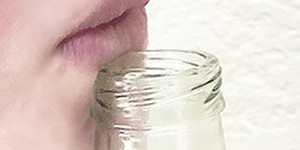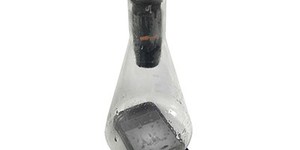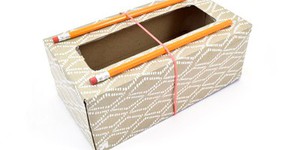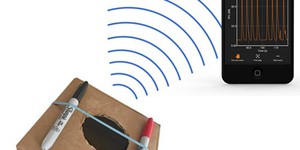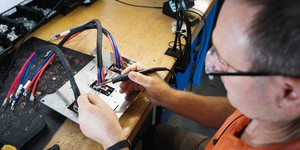Summary
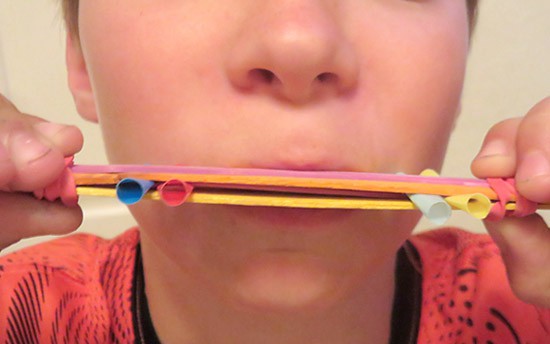
Introduction
Can you name the bestselling musical instrument in the world? If you said harmonica, you are right! The harmonica was said to be patented in 1821 by Christian Buschmann, a 16-year-old German boy. Since then, it has become the top-selling instrument in the world and a household item in many places. Luckily, creating beautiful noise is not just an art—it is also a science! In this activity, you will design and explore your own harmonica-like instrument made from household items. Time to tune up!
Materials
- Two large craft sticks (at least six inches long)
- One wide rubber band (#64 size works well)
- One plastic drinking straw
- Two small rubber bands
- A ruler
- Scissors
- An adult helper
- A piece of paper
- A pen or pencil
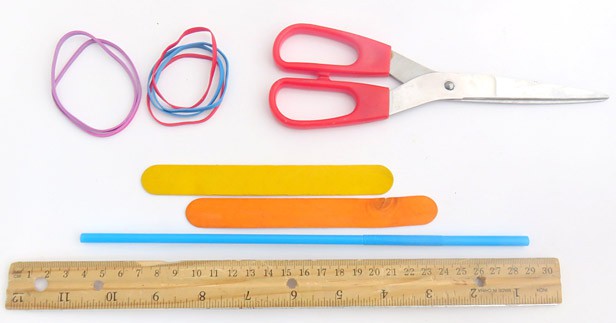 Image Credit: Sabine De Brabandere, Science Buddies / Science Buddies
Image Credit: Sabine De Brabandere, Science Buddies / Science Buddies
Prep Work
- Stretch the wide rubber band over one of the craft sticks lengthwise.
- Use your scissors to cut four pieces of straw, each one to one-and-a-half inches long.
- Place one of the pieces of straw under the rubber band perpendicular to the craft stick, about two inches from the left side of the craft stick. This is Straw 1.
- Place another piece of straw on top of the rubber band to the right of Straw 1. This is Straw 2.
- Place the third piece about two inches from the right side of the craft stick, under the rubber band. This is Straw 3.
- Place the last piece to the right of Straw 3, on top of the rubber band. This is Straw 4.
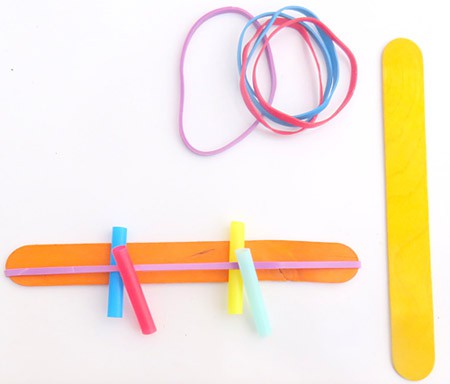 Image Credit: Sabine De Brabandere, Science Buddies / Science Buddies
Image Credit: Sabine De Brabandere, Science Buddies / Science Buddies
- Straws 1 and 4 should be closest to the ends of the craft stick, while Straws 2 and 3 should be in the middle.
- With an adult to help you hold the straws in place, put the second craft stick on top of the first one, creating a sandwich with the pieces of straw between the craft sticks.
- Secure this sandwich by wrapping a small rubber band approximately a half inch from each end of the sticks. The ends of the sticks should be pinched together with a small space between them created by the straws.
 Image Credit: Sabine De Brabandere, Science Buddies / Science Buddies
Image Credit: Sabine De Brabandere, Science Buddies / Science Buddies
- Use your paper and pencil to draw a table with two columns and five rows. Label the first column "distance between middle straws" and fill in each space below with: "2.5 inches," "2 inches," "1.5 inches" and "1 inch." Label the second column "tone of sound."
Instructions
- To start, move Straws 1 and 4 as close to the ends of the craft stick as possible. You can move the straws by gently sliding them back and forth, but be careful not to pull them out of the sandwich!
- Slide Straws 2 and 3 away from each other so that there is a distance of approximately 2.5 inches between them.
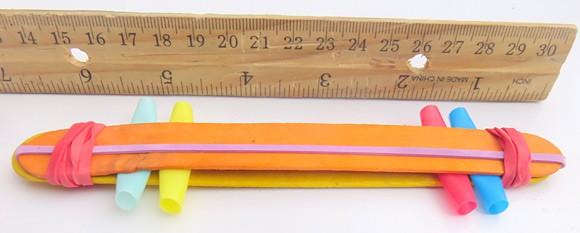 Image Credit: Sabine De Brabandere, Science Buddies / Science Buddies
Image Credit: Sabine De Brabandere, Science Buddies / Science Buddies
- Hold your instrument like a sandwich, with one hand gently holding each end. Try to keep your fingers on the small rubber bands on either side.
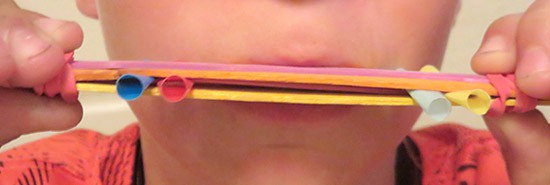 Image Credit: Sabine De Brabandere, Science Buddies / Science Buddies
Image Credit: Sabine De Brabandere, Science Buddies / Science Buddies
- Blow through the opening between the craft sticks as though it is a harmonica (do not blow through the straws!).What sound do you hear? Do you feel anything in your hands as you blow through your instrument? Do the craft sticks vibrate or feel different when you play a sound?
- Move Straws 2 and 3 closer together, so that there is a distance of 2 inches between them.
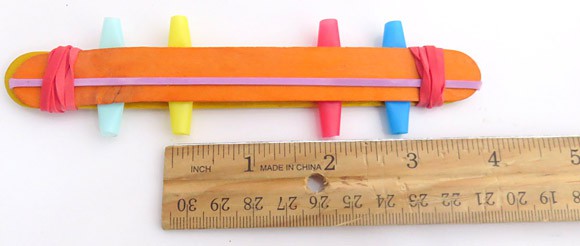 Image Credit: Sabine De Brabandere, Science Buddies / Science Buddies
Image Credit: Sabine De Brabandere, Science Buddies / Science Buddies
- Again, blow through your instrument. Notice the sound and the feeling in your hands.Does this sound different than the first time you played it? If so, in what way? Does the vibration of the instrument feel any different?
- Again, move Straws 2 and 3 closer together, so that there is a distance of 1.5 inches between them.
- Blow through your instrument. Notice the sound and the feeling in your hands.Does this sound different than the other times you played it? If so, in what way? Does the vibration of the instrument feel any different?
- Finally, move Straws 2 and 3 closer together again, so that there is a distance of 1 inch between them.
- Once again, blow through your instrument. Notice the sound and the feeling in your hands.Does this sound different than the other times you played it? If so, in what way? Does the vibration of the instrument feel any different?
- Return Straws 2 and 3 to their original position, with 2.5 inches between them. Repeat the above steps, this time recording your observations about the tone of the sound in your table. To help you compare the sounds, rate the pitch (highness or lowness) of the sound. Score the lowest pitch sound as a 1, and the highest pitch sound as a 4.
- Consider the results in your table.Do you notice any patterns in the tone of the sound? Did the tone change as you moved the straws? If so, did moving the straws closer to each other make the tone higher or lower?
- Remove all of the straws, except for Straw 1. Try blowing through your instrument.Does this sound different than the other times you played it? If so, in what way? Does the vibration of the instrument feel any different?
- Try moving the remaining straw and observing how this affects the tone of the sound.Can you change the tone of the sound by moving the straw?
- Use two other craft sticks, small rubber bands and at least one piece of straw to build a harmonica without the central wide rubber band. You can also disassemble your harmonica and reuse the pieces to perform this test.
 Image Credit: Sabine De Brabandere, Science Buddies / Science Buddies
Image Credit: Sabine De Brabandere, Science Buddies / Science Buddies
- Try blowing through your new instrument.Can you make a sound? If so, is the sound different than the other times you played it? Do the craft sticks vibrate or feel different when you blow through it?
What Happened?
The sound made by your instrument is actually the sound created by the large rubber band vibrating as you blow through it, just as a violin string vibrates when played by a violinist. As you blew through your instrument, you might have noticed that you could feel the vibrations through the craft stick. When you rebuilt the instrument without the large rubber band, you probably found that you could not produce any sound when you blew through it. From this you can observe that the large rubber band was essential to creating sound, and that vibrations accompanied the sound.
In addition, you might have noticed that you could change the tone of the sound by moving the straws. When you moved Straws 2 and 3 closer together, the vibrating section of the rubber band got shorter and the tone of the sound got higher. The shorter section of rubber band vibrates more quickly, and our ears pick this up as a higher-pitch sound.
When you removed all but one straw, you probably found that the pitch of the instrument became lower. With only one straw, the vibrating part of the rubber band was probably longer, vibrated slower, and generated a lower-pitch sound. As you moved the remaining straw, you could change the tone as the vibrating part of the rubber band became shorter or longer.
Digging Deeper
The sounds we hear every day are sound waves traveling through the air and reaching our ears. Much like a wave in a pool is created by a disturbance (e.g. a person jumping in), sound waves are generated by the vibration or rapid back-and-forth motion of an object. Waves in the pool travel through water, while sound waves most commonly travel through air. The vibrating object, such as a vocal cord or a violin string, bumps into air particles around it. The air particles then bump into nearby air particles, and the sound wave travels through the air.
Blowing air through your harmonica causes the rubber band to vibrate. The vibrating rubber band bumps against the air particles and as such, generates a sound wave. The vibration happens at a specific rate and generates a sound of the same frequency. The frequency is commonly measured in Hertz (Hz), where one Hertz equals one vibration per second. Humans typically hear sounds with a frequency between 20 and 20,000 Hz.
To understand the frequency or number of vibrations per second, imagine two people holding a rope between them. If one person gently shakes the rope up and down once per second, a wave will travel through the rope with a frequency of 1 Hz, or one vibration per second. If the person increases the speed and moves the rope up and down twice per second, a wave will travel through the rope at a frequency of 2 Hz.
We perceive the frequency of a sound wave by the pitch of the tone: a high frequency wave is perceived as high pitch tone and a low frequency wave sounds low. When you shortened the vibrating part of the rubber band, it vibrated more quickly or at a higher frequency and thus, produced a higher pitch tone. Similarly, men tend to have longer vocal chords than women and therefore their voices are generally lower than women's voices. You could also use a thinner rubber band or stretch the vibrating section tighter to create a higher pitch.
Ask an Expert
For Further Exploration
- Make a second harmonica similar to the first one, but replace the wide rubber band by thinner or shorter rubber bands. Do these two harmonicas sound the same? Make sure the straw placements are identical when comparing the sound created by the two harmonicas.
- Test larger and/or smaller craft sticks and materials other than the straws. How many different instruments can you make?
- Can you find other vibrating objects and make tones of different pitch with them?
- Use your smartphone or tablet and learn to use the Google Science Journal app to measure the pitch of your harmonica. The app exists for your Android and iOS devices.
Related Resources
Project Ideas
Activities
Lesson Plans
- 1-PS4-1. Plan and conduct investigations to provide evidence that vibrating materials can make sound and that sound can make materials vibrate.
- MS-PS4-1. Use mathematical representations to describe a simple model for waves that includes how the amplitude of a wave is related to the energy in a wave.
Links
- Blog Post: DIY Musical Instruments


